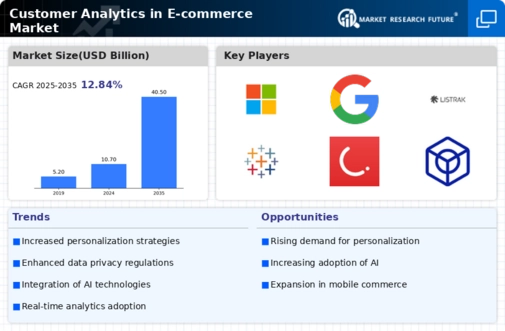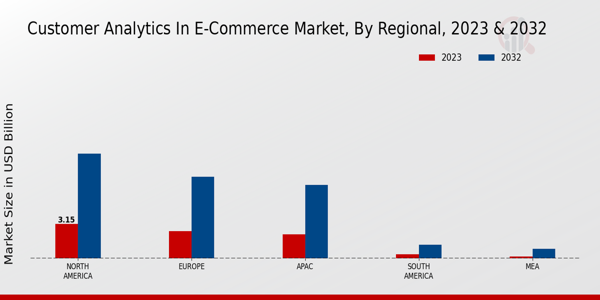Market Growth Visualization
The Global Customer Analytics in E-commerce Market Industry is poised for substantial growth, with projections indicating a market value of 10.7 USD Billion in 2024 and an anticipated increase to 40.5 USD Billion by 2035. This growth trajectory reflects a compound annual growth rate of 12.85% from 2025 to 2035. The visualization of this market growth underscores the increasing importance of customer analytics in shaping e-commerce strategies and enhancing customer experiences.
Expansion of E-commerce Platforms
The expansion of e-commerce platforms significantly influences the Global Customer Analytics in E-commerce Market Industry. As more businesses establish an online presence, the volume of customer data generated increases exponentially. This data serves as a valuable resource for analytics, enabling companies to understand consumer behavior and preferences better. The rise of mobile commerce further amplifies this trend, as consumers increasingly shop via smartphones and tablets. The projected growth of the market to 40.5 USD Billion by 2035 highlights the potential for businesses to harness customer analytics effectively. Companies that adapt to this expanding digital landscape are likely to thrive.
Rising Demand for Personalization
The Global Customer Analytics in E-commerce Market Industry experiences a notable surge in demand for personalized shopping experiences. As consumers increasingly seek tailored recommendations, businesses leverage customer analytics to analyze purchasing behavior and preferences. This trend is evidenced by the projected market value of 10.7 USD Billion in 2024, indicating a growing recognition of the importance of personalization. Companies that utilize advanced analytics tools can enhance customer engagement and loyalty, potentially leading to higher conversion rates. The ability to deliver personalized content and product suggestions is becoming a critical differentiator in the competitive e-commerce landscape.
Emergence of Omnichannel Retailing
The emergence of omnichannel retailing is reshaping the Global Customer Analytics in E-commerce Market Industry. Consumers now expect a seamless shopping experience across various channels, including online and brick-and-mortar stores. This shift necessitates the integration of customer analytics to track interactions across multiple touchpoints. By understanding customer journeys, businesses can tailor their marketing strategies and enhance overall customer satisfaction. The anticipated growth of the market to 40.5 USD Billion by 2035 suggests that companies investing in omnichannel strategies and analytics are likely to achieve greater customer loyalty and retention.
Increased Focus on Customer Retention
The Global Customer Analytics in E-commerce Market Industry is witnessing a heightened emphasis on customer retention strategies. Companies recognize that retaining existing customers is often more cost-effective than acquiring new ones. By utilizing customer analytics, businesses can identify at-risk customers and implement targeted retention campaigns. This approach not only enhances customer loyalty but also contributes to long-term profitability. The projected CAGR of 12.85% from 2025 to 2035 reflects the growing importance of customer retention in the e-commerce sector. Organizations that prioritize customer analytics in their retention strategies are likely to see improved customer lifetime value.
Advancements in Data Analytics Technologies
Technological advancements play a pivotal role in shaping the Global Customer Analytics in E-commerce Market Industry. The integration of artificial intelligence and machine learning into analytics platforms enables businesses to process vast amounts of data efficiently. These technologies facilitate real-time insights, allowing companies to adapt their strategies swiftly. As a result, organizations can optimize their marketing efforts and improve customer satisfaction. The anticipated growth of the market to 40.5 USD Billion by 2035 underscores the significance of these innovations. Businesses that embrace cutting-edge analytics technologies are likely to gain a competitive edge in the evolving e-commerce environment.















